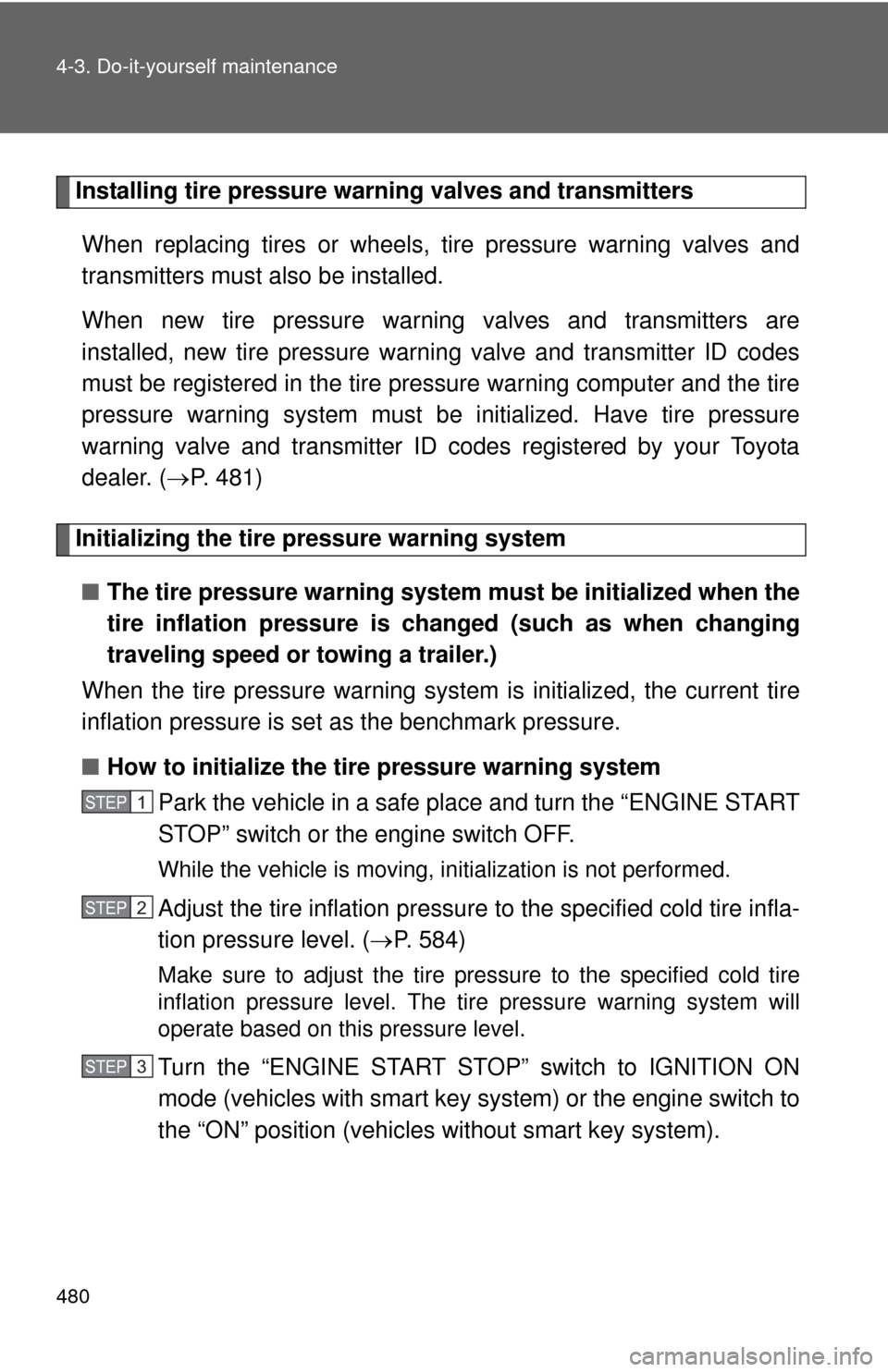Page 5 of 636

1
2
3
4
5
6
7
5
4-1. Maintenance and careCleaning and protecting the vehicle exterior............ 440
Cleaning and protecting the vehicle interior............. 443
4-2. Maintenance Maintenance requirements ..................... 446
General maintenance.......... 449
Emission inspection and maintenance (I/M)
programs........................... 452
4-3. Do-it-yourself maintenance Do-it-yourself service precautions ....................... 453
Hood ................................... 457
Positioning a floor jack ........ 459
Engine compartment ........... 463
Tires .................................... 478
Tire inflation pressure ......... 487
Wheels ................................ 490
Air conditioning filter............ 493
Wireless remote control/ electronic key battery ........ 496
Checking and replacing fuses ................................. 499
Light bulbs........................... 510 5-1. Essential information
Emergency flashers............ 518
If your vehicle needs to be towed........................... 519
If you think something is wrong ............................ 526
Fuel pump shut off system .............................. 527
5-2. Steps to take in an emergency
If a warning light turns on or a warning buzzer
sounds... .......................... 528
If a warning message is displayed .......................... 539
If you have a flat tire ........... 540
If the engine will not start.... 554
If the shift lever cannot be shifted from P ................... 556
If you lose your keys/ wireless remote control
transmitter ........................ 557
If the electronic key does not operate properly ......... 558
If the battery is discharged........................ 560
If your vehicle overheats .... 564
4Maintenance and care5When trouble arises
Page 9 of 636
9
Tires
●Rotation
● Replacement
● Inflation pressure
● Information
P. 478
P. 540
P. 584
P. 590
: If equipped
Back door P. 60
Side doors P. 54
Stop/tail and rear side
marker lights
P. 200
Rear window wiper P. 212
Rear window defogger
Glass hatch
P. 289
P. 70
License plate lights P. 200
Rear turn signal lights P. 182
Fuel filler door P. 109
Page 439 of 636
Maintenance and care4
439
4-1. Maintenance and careCleaning and protecting the vehicle exterior......... 440
Cleaning and protecting the vehicle interior.......... 443
4-2. Maintenance Maintenance requirements .................. 446
General maintenance....... 449
Emission inspection and maintenance (I/M)
programs........................ 452 4-3. Do-it-yourself
maintenance
Do-it-yourself service precautions .................... 453
Hood ................................ 457
Positioning a floor jack ..... 459
Engine compartment ........ 463
Tires ................................. 478
Tire inflation pressure ...... 487
Wheels ............................. 490
Air conditioning filter......... 493
Wireless remote control/ electronic key battery ..... 496
Checking and replacing fuses .............................. 499
Light bulbs........................ 510
Page 451 of 636
451
4-2. Maintenance
4
Maintenance and care
Vehicle exterior
ItemsCheck points
Door • Operate smoothly?
Engine hood • The lock system works properly?
Fluid leaks • Is there any leakage after park-
ing?
Tire • Inflation pressure is correct?
• Tire surfaces not worn or dam-
aged?
• Tires rotated according to the maintenance schedule?
• Wheel nuts are not loose?
CAUTION
■ If the engine is running
Turn the engine off and ensure that there is adequate ventilation before per-
forming maintenance checks.
Page 454 of 636
454 4-3. Do-it-yourself maintenance
ItemsParts and tools
Fuses ( P. 499)• Fuse with same amperage rating
as original
Radiator and condenser (P. 471)
Tire inflation pressure (
P. 487) • Tire pressure gauge
• Compressed air source
Washer fluid
(P. 477) • Water washer fluid containing
antifreeze (for winter use)
• Funnel
Page 478 of 636
478
4-3. Do-it-yourself maintenance
Tires
Replace or rotate tires in accordance with maintenance sched-
ules and treadwear.
■Checking tires
New tread
Treadwear indicator
Worn tread
The location of treadwear
indicators is shown by the
“TWI” or “ ” marks, etc.,
molded on the sidewall of
each tire.
Check spare tire condition
and inflation pressure if not
rotated.
■Tire rotation
Rotate the tires in the order
shown.
To equalize tire wear and
extend tire life, Toyota recom-
mends that tire rotation is
carried out at the same inter-
val as tire inspection.
Front
Page 479 of 636
479
4-3. Do-it-yourself maintenance
4
Maintenance and care
■
The tire pressure warning system
Your Toyota is equipped with a tire pressure warning system that
uses tire pressure warning valves and transmitters to detect low
tire inflation pressure before serious problems arise.
( P. 531, 539)
Page 480 of 636

480 4-3. Do-it-yourself maintenance
Installing tire pressure warning valves and transmittersWhen replacing tires or wheels, tire pressure warning valves and
transmitters must also be installed.
When new tire pressure warning valves and transmitters are
installed, new tire pressure warn ing valve and transmitter ID codes
must be registered in the tire pressure warning computer and the tire
pressure warning system must be initialized. Have tire pressure
warning valve and transmitter ID codes registered by your Toyota
dealer. ( P. 481)
Initializing the tire pressure warning system
■ The tire pressure warning system must be initialized when the
tire inflation pressure is changed (such as when changing
traveling speed or towing a trailer.)
When the tire pressure warning syst em is initialized, the current tire
inflation pressure is set as the benchmark pressure.
■ How to initialize the tire pressure warning system
Park the vehicle in a safe place and turn the “ENGINE START
STOP” switch or the engine switch OFF.
While the vehicle is moving, in itialization is not performed.
Adjust the tire inflation pressure to the specified cold tire infla-
tion pressure level. ( P. 584)
Make sure to adjust the tire pressure to the specified cold tire
inflation pressure level. The ti re pressure warning system will
operate based on this pressure level.
Turn the “ENGINE START STOP” switch to IGNITION ON
mode (vehicles with smart key system) or the engine switch to
the “ON” position (vehicles without smart key system).
STEP1
STEP2
STEP3